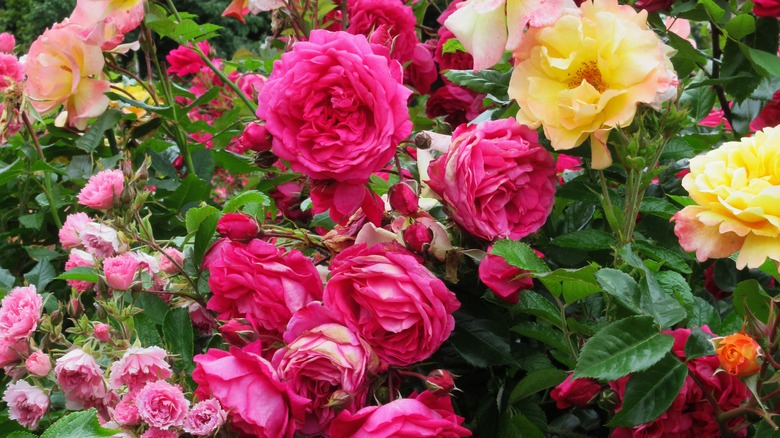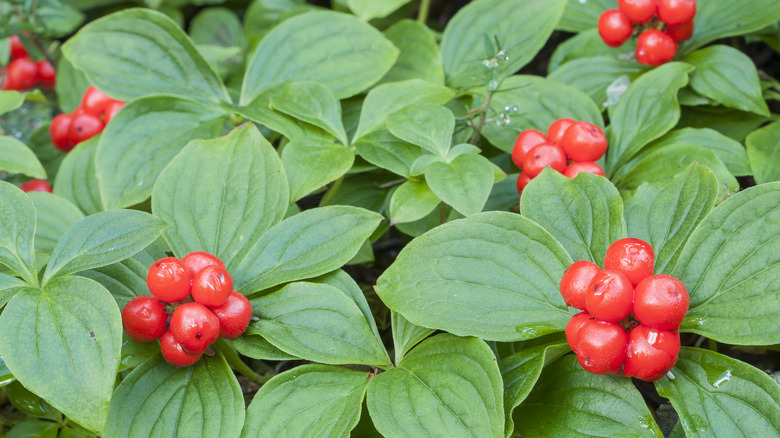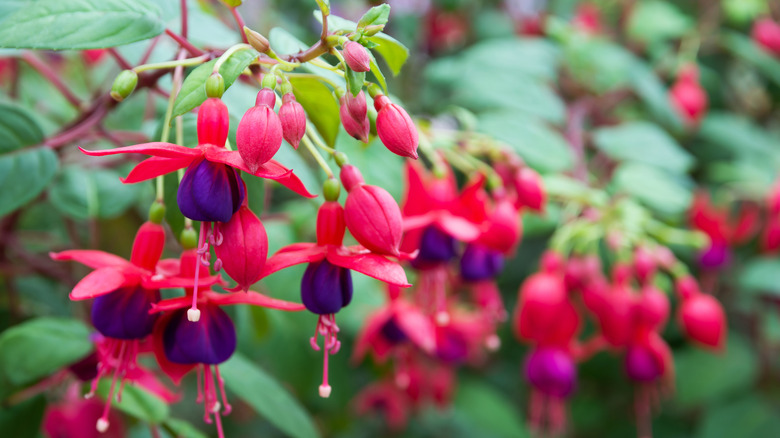Plants That You Won't Want In Your Rose Garden
Every spring, we tend to our gardens and prepare for the bright blooms of our favorite flowers, roses usually among them. Coming in many shapes, sizes, and colors, roses are a beloved plant, never failing to bring us butterflies, bees, and sweet aromas. Companion planting is one way that you can help your rose garden thrive this season. This technique pairs plants, whether flowers or vegetables, with others that will enhance and strengthen their growth. A few examples of companion planting would be tomatoes with basil or planting garlic around garden perimeters to fend off harmful insects and weeds.
While pairing certain plants can bring in more pollinators, provide extra shade, and deter invasive weeds or pests, some foliages have the opposite effect. If you match your roses with plants needing vastly different care, you risk one or both dying off. Certain types like bunchberry, toad lilies, leopard plants, and fuchsia are among those that can do more harm than good if planted alongside your roses. It's important to understand that roses need full sunlight and aerated, nutritious soils with low nitrogen to flourish. Planting them next to flowers that prefer incredibly moist and shaded conditions won't give your perennials the care they need for a healthy growing season.
Bunchberry and toad lilies
Bunchberry is a crawling perennial that keeps close to the ground. Part of the dogwood family and also known as the Dwarf Cornel, bunchberry boasts white-yellowish flowers and produces small clumps of red berries. The pomes are edible and often used for medicinal purposes. However, they won't do much to help your rose garden. Needing excessive shade and water, your roses will be prone to withering and root rot if paired with bunchberry. Even though it can do well in draining soils like roses, the consistently wet climate it craves will always be more than roses can handle.
Toad lilies have an alluring presentation with their orchid-like blossoms that sport a white base with purple spots littered along their petals. Toad lilies can also be found in pinks and blues, adding plentiful color wherever they grow. These plants are native to Asia in places such as India, China, and Japan and require lots of moisture, rich soil, and partial to full shade. They are also prone to attract rabbits, which is already a prominent issue with roses. Toad lilies are much better suited if planted with hostas, ferns, and other shade-loving plants.
Leopard plants and fuchsia
Leopard plants resemble daisies with their smaller flowers and elongated petals. Also known as Ligularia or Farfugium, their leaves sometimes showcase a speckled pattern, giving them the leopard title. These Asian-native flowers do best in cool and shaded areas with aerated soil kept consistently moist. Not only are roses likely to get root rot from a ground that's overly wet, but they need full sunlight, while leopard plants are damaged in the sun's harsh heat.
Native to Central and South America, fuchsia produces vibrant flowers that hang and dangle, similar to that of a lily of the valley. Its common bright pink and purplish-blue hue attracts many to this plant, but it is not a good fit to pair with your lovely roses. Like the other species mentioned, fuchsia needs a cool and wet climate for the most successful growth. Because of how moist it like its soil, fuchsia is prone to diseases, which will also not bode well for a rose garden.


